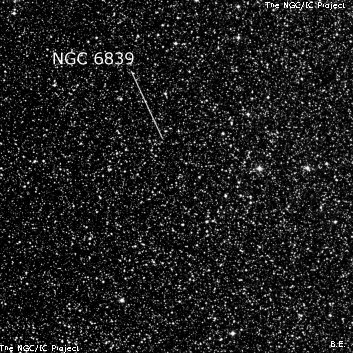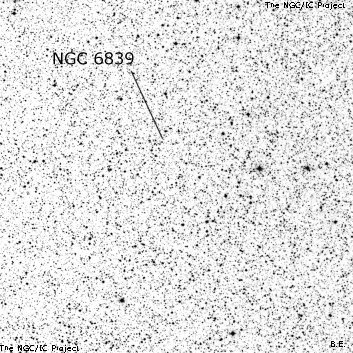NGC/IC Project Restoration Effort
(This is a very very beta version)
NGC6839


Basic Information
Location and Magnitude
Right Ascension: 19:54:33.0
Declination: +17:56:20
Constellation: SGE
Visual Magnitude:
Historic Information
Discoverer: Herschel W.
Year of discovery: 1784
Discovery aperture: 18.7
Observational
Summary description: Cl, vS, vC
Sub-type: *Grp
Corwin's Notes
=====
NGC 6839. Earlier I wrote:
WH has one observation of this on 18 August 1784; it was the only object
(not a star or double star) that he found that night. His description reads
only "A very small cluster of compressed stars." There is nothing like that
in the area. JH swept over the spot twice and did not positively identify
the cluster either time. The position he gives for one observation is
probably that reduced by CH, but he puts plus-minus signs on both
coordinates. There are several small clumps of stars in the area that might
be WH's object, but none stand out on POSS1, GSC, or DSS.
It is barely possible that this could be M 71 (NGC 6838) which is 45 seconds
preceding and 53 arcmin north of WH's nominal position. Since WH recorded
no other nebulae or clusters that night, we can't say anything about
systematic errors without digging into the detailed records of his sweep.
The offset to M 71 is not unheard of in WH's observations, but it IS rare
for him to have such a large position error. And M 71 is hardly a "very
small" cluster.
Steve Gottlieb has finally dug into the sweep (No. 252) and has found that
this was NOT the only non-stellar object found that night. NGC 6838 (M 71) is
actually the previous object in the sweep, referred to the same star
(8 Sagittae), so it cannot also be NGC 6839.
While there isn't anything obvious at WH's position that matches his
description, Steve has found a candidate nearby; here is his report from 23
September 1995 with his 17.5-inch reflector.
[A]t 100x there is a very weak enhancement of stars within 10' of mag 8.6
SAO 105398 at 19 54 04 +17 57.1 [2000]. More noticeable, though, is a
partially resolved clump of faint stars just 3' NW. At 225x this fairly
rich clump is resolved into 15 mag 13.5-14.5 stars in a 3' region elongated
NNW-SSE. There are also scattered mag 10-12 stars to the southeast of SAO
105398 but these don't catch the eye. Located 50' S of M 71.
The "clump" or string I mentioned is roughly centered at 19 54 00 +18 00.2.
Still, the question remains why he [WH] didn't mention the nearby mag 8.5
star which is just 3' away. Otherwise, I don't see a reasonable candidate
nearby.
The group is pretty well seen on the DSS images, and I've included it in the
main table as a candidate for WH's object. I've also included all of the
positions reducible from WH's observations: 1) that from the offsets
published by WH in the original Philosophical Transactions list and included
in the Scientific Papers; 2) that from the 1800 position given in CH's fair
copy of the Sweep; and 3) that from the offsets in the Sweep, reduced with
respect to his comparison star, taking proper motion into account.
Steve's Notes
=====
NGC 6839
17.5" (9/23/95): at 100x there is a very weak enhancement of stars within 10' of mag 8.6 SAO 105398 at 19 54 04 +17 57.1. More noticeable, though, is a partially resolved clump of faint stars just 3' NW. At 225x this fairly rich clump is resolved into 15 mag 13.5-14.5 stars in a 3' region elongated NNW-SSE. There are also scattered mag 10-12 stars to the southeast of SAO 105398 but these don't catch the eye. Located 50' S of M71. The identification of this number is very uncertain.



